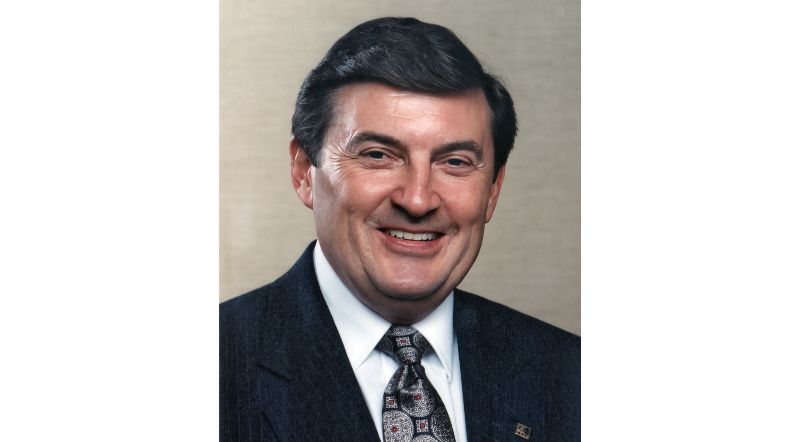Former Owens President Daniel H. Brown Dies
(From Owens Community College)
Daniel H. Brown, the Owens Community College president who would headline a Mount Rushmore of the college’s most prominent leaders, died Wednesday, October 2. He was 89. His obituary is posted here.
Brown was named the third president of Owens in August 1984, following Jacob See. He retired in June 2001 and was succeeded by Christa Adams.
Brown was a visionary who advanced the college’s technology programs through partnerships and new construction and enhanced the arts and sciences programs for expanded access, leading Owens to become a comprehensive state community college.
He was known for arriving early and staying late as well as for being hands-on with building projects and student initiatives. He wanted to ensure Owens helped students succeed and met workforce training needs.
“President Brown and his wife, Nancy, attended the grand opening of our Dana Center in 2021. They were so kind to me and were interested about the new advanced manufacturing training center,” Owens President Dr. Dione D. Somerville said. “We are saddened to learn of his passing and extend our condolences to his family.
“President Brown leaves behind a profound and lasting legacy at Owens Community College. We will always be grateful for his vision, his commitment and his impact,” Somerville said.
Brown began working at Owens in 1966, one year after the college opened as Penta Technical College, and held a variety of roles before becoming president. He was the dean of the Owens Lima Campus, which is now Rhodes State College, as well as vice president of student services and assistant to the president.
Owens was a tight-knit community under President Brown with Brown knowing all employees by their first name, according to Pat Jezak, special assistant to Dr. Somerville who’s worked at Owens for 35 years.
Owens grew exponentially during the Brown presidency, expanding to the east side of Oregon Road on the Toledo-area Campus, adding the Findlay-area Campus and increasing headcount enrollment.
On the Toledo-area Campus, land on the east side of Oregon Road was acquired and five buildings were built under his leadership. The last of the five to open was the Student Health and Activities Center, moving the home of Owens Express athletics from Alumni Hall to the new, modern facility.
Brown shifted financial support to help Owens Express teams grow and succeed. Men’s basketball was a staple at the beginning of his presidency. Women’s basketball, volleyball, men’s soccer and softball were added in the 1990s.
Brown was inducted in the Owens Express Athletics Hall of Fame in 2017.
“Dan Brown was the biggest fan of the Owens Express,” said Jim Welling, the former men’s basketball coach who is enshrined in the NJCAA and Owens athletics halls of fame. “He attended every game that he could. He made sure we had the resources we needed to succeed. He knew the players. He knew the players’ families.
“He always came through for what we needed in athletics. He was a tireless worker. He was not only a great administrator; he was great friend. He will be missed by everyone who knew him,” Welling added.
Also on the east side of campus, the new Industrial/Engineering Technologies Building and Transportation Technologies Center housed partnerships that Brown helped establish, including with corporations such as John Deere, General Motors, Ford Motor Company and Caterpillar Inc. Students enjoyed pathways to new careers with these companies. The Owens automotive program was named the nation’s best in 1994.
Also in 1994, Brown was instrumental in helping transition Owens from a technical college to a comprehensive community college, which expanded the curriculum so that students could earn the first two years of a bachelor’s degree and then transfer to 4-year institutions. Owens changed its name from Owens Technical College to Owens Community College at that time.
The original Findlay-area Campus, located at the corner of Cory and Davis streets in downtown Findlay, was established, expanding the Owens footprint south along the I-75 corridor.
Brown’s tenure spanned headcount enrollment growth from a few hundred students in his first year of employment to approximately 4,500 in the first year of his presidency to 17,000 at his retirement.
Owens even lowered tuition in Brown’s penultimate academic year, leading to front-page media coverage and editorial praise.
Adding to his lasting legacy, President Brown endowed a scholarship at his retirement. It has supported more than 60 students all told, according to records. Open to all students, the scholarship gives preference to School of Nursing and Health Professions students.
“President Brown was the type of leader who you wanted to follow. You liked working with him,” said Ronald A. McMaster, a member of the Owens Community College Foundation board who served on the Owens Board of Trustees from 1993-2018. “He was confident, decisive and driven. If you want to talk about a legacy, President Brown was instrumental in building the foundation of what Owens Community College is today.”

